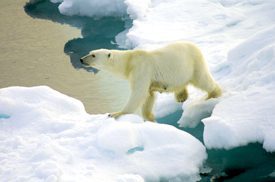 Perhaps nothing has come to symbolize the effects of climate change upon the animal kingdom better than the plight of that great white creature of the North, Ursus maritimus, the Arctic Polar Bear. As mighty as these bears may be, many of the world’s leading environmental and wildlife organizations are spending a great deal of time and money lobbying for more complete Federal protection of the Bear under the Endangered Species Act. Simply put, this is a fight to save a species from extinction due to loss of habitat from Global Warming-related Arctic ice melt. As melts the ice, so melts the surface on which they hunt, travel, and rest, and in as few as three or four years, the entire annual summer ice platform may be gone, further threatening Polar Bear existence even more.
Perhaps nothing has come to symbolize the effects of climate change upon the animal kingdom better than the plight of that great white creature of the North, Ursus maritimus, the Arctic Polar Bear. As mighty as these bears may be, many of the world’s leading environmental and wildlife organizations are spending a great deal of time and money lobbying for more complete Federal protection of the Bear under the Endangered Species Act. Simply put, this is a fight to save a species from extinction due to loss of habitat from Global Warming-related Arctic ice melt. As melts the ice, so melts the surface on which they hunt, travel, and rest, and in as few as three or four years, the entire annual summer ice platform may be gone, further threatening Polar Bear existence even more.
According to numbers supported by the US Fish & Wildflife Service, NRDC, Polar Bear International and others groups, approximately 20,000 to 25,000 bears remain in habitat, 60 percent of which are in Canada, and about 4,700 in Alaska. Although experts and climate scientists predict numbers could crash by over two thirds (including the entire population in Alaska) by 2050, there had been some hope on the horizon in the form of the more environmentally friendly Obama Administration. The key to this however, was whether Secretary of the Interior Ken Salazar would reinstate the provisions within the Endangengered Species Act which were dangerously stripped out by the Bush Administration in the remaining hours of 2008. Although the Act does designate Polar Bears as Threatened, with the presence of the so-called Bush era 4(d) rule put in place by then-Secretary Kempthorne, it does not protect them enough from the direct and indirect detrimental effects of green house gases and oil development.
But with the May 9 deadline come and gone, and no repeal of the 4(d) rule, Secretary Salazar has severely disappointed many scientists, environmentalists, and wildlife advocacy groups who thought that the Obama administration would bring the protections needed for the polar bear to feasibly survive in sufficiently high numbers beyond the 2050 time window. Without the full protection of an emboldened Endangered Species Act, populations will likely not have a chance of remaining stable and avoiding the precipitous declines so predicted by worldwide experts.
For those interested in reading more about this crucial cause and effect relationship between animal and environment, please visit the following sites for a wealth of information, including facts and figures from numerous ongoing studies of Polar Bears, to descriptions of the various campaigns striving to spread much needed public awareness about this and related issues.
Sources and Further Reading:
Center for Biological Diversity
National Wildlife Federation
NRDC
Polar Bear International
Wildlife Conservation Society
World Wildlife Fund
Sierra Club
US Fish & Wildlife Service


